Inverness History Facts and Timeline
(Inverness, Scotland, UK)
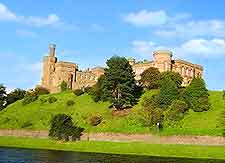
Today, Inverness is known as the capital of the Scottish Highlands. To find its origins, however, we need to step back in time to the 6th century AD when a group of Pictish people lived here. Their king was known variously as Brude or Bridei and he held court in his fort on Craig Phadraig, which is to the west of the present-day city of Inverness.
There's evidence that the Irish missionary St. Columbia visited the settlement in 565 AD in an attempt to convert its inhabitants to Christianity. Whether or not he met with much success isn't known.
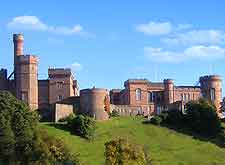
The ancient fort has not survived the test of time. However, it lives on in history thanks to William Shakespeare. In his play 'Macbeth', this is the place where Macbeth built his stronghold and where he murdered the unfortunate Duncan.
Inverness in the Middle Ages
In the 12th century, King David I made Inverness a royal burgh and it soon developed into a busy town and port, trading in everything from fish and furs to timber and wool. A castle was built here and, later on, a bridge was built over the River Ness.
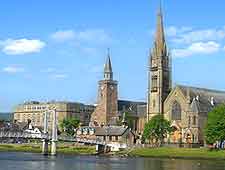
This was an unstable period in Scotland's history, however, and Inverness was a prime target for incursions by both Scottish clans and English forces. During the Scottish Wars of Independence, control of the castle was hotly contested. It was finally seized by Robert the Bruce in 1307.
In 1562, Inverness Castle was once again besieged. In September of that year, Mary, Queen of Scots was denied entry by Alexander Gordon, chief of the Clan Gordon. Two clans came to Mary's rescue, laying siege to the castle, and after three days it fell. Gordon was executed and Mary spent just four nights here.
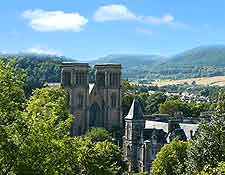
The 17th and 18th Centuries
The strategic importance of Inverness did not go unnoticed by Cromwell in the 17th century. In 1652, Cromwell started to build a stronghold on the right bank of the river. Completed in 1657, the citadel was not to survive long. With the restoration of King Charles II, it was almost completely demolished.
In 1745, Inverness Castle was once again occupied, this time by Bonnie Prince Charlie and his Jacobite followers. Fearing it would fall into the hands of the British Government, the rebel leaders' forces ordered its destruction. They were later to be defeated at nearby Culloden.
19th-Century History to the Present Day
The building of the Caledonian Canal in 1822 brought much-needed trade to Inverness. When completed, it linked the town with western Scotland. Built by engineer Thomas Telford, the canal offered safe passage to sailing ships that had previously had to risk the stormy seas north of Scotland.
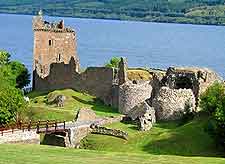
Later, in the 1850s, the railway also arrived in Inverness. This time, it wasn't just the import and export trade that stood to benefit. The railway brought with it crowds of tourists, including wealthy businessmen and aristocrats, all keen to try their hand at deer hunting and salmon fishing. One visitor in particular, Queen Victoria, did much to promote the delights of a holiday in the Highlands.
The town's wealth was used to fund a busy public building programme, including an infirmary, St. Andrew's Cathedral and the Town House. In 1836, work on constructing a new castle was started. Built on the site of the old castle, this one was to be a much more comfortable affair, with gas, lighting and water. By the late 1800s, Inverness also had three new bridges - Waterloo Bridge, Ness Bridge and the Infirmary footbridge.
In 1921, Inverness hosted a meeting of the British Cabinet. It's thought that this is the only time this has happened outside of London. It took until 2001 for Inverness to acquire city status. Today, it is a lively city and popular tourist destination. It remains relatively small, however, with a population of just 60,000 people.
 Today, Inverness is known as the capital of the Scottish Highlands. To find its origins, however, we need to step back in time to the 6th century AD when a group of Pictish people lived here. Their king was known variously as Brude or Bridei and he held court in his fort on Craig Phadraig, which is to the west of the present-day city of Inverness.
Today, Inverness is known as the capital of the Scottish Highlands. To find its origins, however, we need to step back in time to the 6th century AD when a group of Pictish people lived here. Their king was known variously as Brude or Bridei and he held court in his fort on Craig Phadraig, which is to the west of the present-day city of Inverness. The ancient fort has not survived the test of time. However, it lives on in history thanks to William Shakespeare. In his play 'Macbeth', this is the place where Macbeth built his stronghold and where he murdered the unfortunate Duncan.
The ancient fort has not survived the test of time. However, it lives on in history thanks to William Shakespeare. In his play 'Macbeth', this is the place where Macbeth built his stronghold and where he murdered the unfortunate Duncan. This was an unstable period in Scotland's history, however, and Inverness was a prime target for incursions by both Scottish clans and English forces. During the Scottish Wars of Independence, control of the castle was hotly contested. It was finally seized by Robert the Bruce in 1307.
This was an unstable period in Scotland's history, however, and Inverness was a prime target for incursions by both Scottish clans and English forces. During the Scottish Wars of Independence, control of the castle was hotly contested. It was finally seized by Robert the Bruce in 1307.
 Later, in the 1850s, the railway also arrived in Inverness. This time, it wasn't just the import and export trade that stood to benefit. The railway brought with it crowds of tourists, including wealthy businessmen and aristocrats, all keen to try their hand at deer hunting and salmon fishing. One visitor in particular, Queen Victoria, did much to promote the delights of a holiday in the Highlands.
Later, in the 1850s, the railway also arrived in Inverness. This time, it wasn't just the import and export trade that stood to benefit. The railway brought with it crowds of tourists, including wealthy businessmen and aristocrats, all keen to try their hand at deer hunting and salmon fishing. One visitor in particular, Queen Victoria, did much to promote the delights of a holiday in the Highlands.